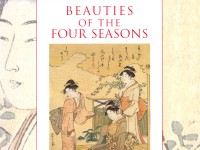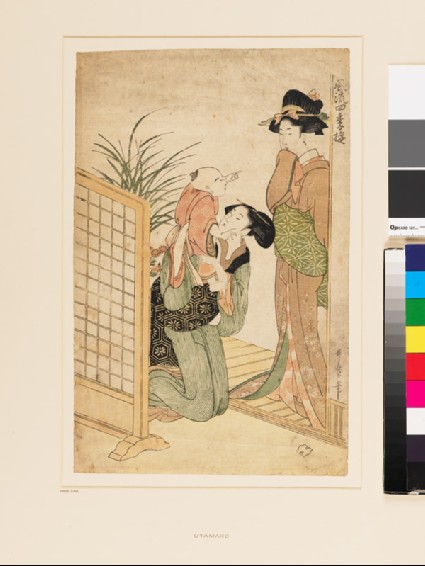Beauties of the Four Seasons
A full catalogue of the Ashmolean’s collection of Japanese bijinga (beautiful women) prints by Mitsuko Watanabe (published Oxford, 2005).

Publications online: 54 objects
- Reference URL
Actions
Mother, child, and nurse
-
Literature notes
In this print a woman is kneeling down holding a child, and another is standing outside on the veranda. There is a chrysanthemum bonsai behind the shōji tsuitate (a free-standing screen) in the cheerful mood of autumn.
In the Edo period, gardening became very popular. The chrysanthemum was among the first plants introduced into this new fashion. There were even kikuawase in which people showed their own chrysanthemums competing for the most beautiful chrysanthemum to be seen that autumn.
The stamp on the bottom right is the unidentified mark of a publisher. There is a series called Fūryū Shiki no Asobi published by Tsurushin during the Kyōwa period (1801-4) very similar to the present series. -
Details
- Series
- Elegant Amusements of the Four Seasons
- Associated place
- Date
- c. 1800
- Artist/maker
-
Kitagawa Utamaro (c. 1753 - 1806) (designer)
- Material and technique
- nishiki-e (multi-block) woodblock print, printed with water-based vegetable pigments
- Dimensions
-
mount 55.5 x 40.5 cm (height x width)
sheet 39.5 x 27 cm (height x width)
print 35.5 x 22.9 cm (height x width)
- Material index
- Technique index
- Object type index
- No. of items
- 1
- Credit line
- Bequeathed by Oswald J. Couldrey, 1958.
- Accession no.
- EA1958.248
-
Further reading
Oxford: Ashmolean Museum, 24 August-30 November 2005, Beauties of the Four Seasons, Mitsuko Watanabe, ed. (Oxford: Ashmolean Museum, 2005), no. 16 on p. 32, illus. p. 33
Glossary (2)
nishiki-e, vegetable pigments
-
nishiki-e
Nishiki-e literally means 'brocade pictures' and refers to multi-coloured woodblock prints.
-
vegetable pigments
Vegetable pigments were used to create coloured dyes for Japanese prints, paintings, and textiles. These pigments often faded over time due to the chemical reactions they underwent.
Location
-
- currently in research collection
Objects are sometimes moved to a different location. Our object location data is usually updated on a monthly basis. Contact the Jameel Study Centre if you are planning to visit the museum to see a particular object on display, or would like to arrange an appointment to see an object in our reserve collections.
Publications online
-

Beauties of the Four Seasons
In this print a woman is kneeling down holding a child, and another is standing outside on the veranda. There is a chrysanthemum bonsai behind the shōji tsuitate (a free-standing screen) in the cheerful mood of autumn.
In the Edo period, gardening became very popular. The chrysanthemum was among the first plants introduced into this new fashion. There were even kikuawase in which people showed their own chrysanthemums competing for the most beautiful chrysanthemum to be seen that autumn.
The stamp on the bottom right is the unidentified mark of a publisher. There is a series called Fūryū Shiki no Asobi published by Tsurushin during the Kyōwa period (1801-4) very similar to the present series.
Notice
Object information may not accurately reflect the actual contents of the original publication, since our online objects contain current information held in our collections database. Click on 'buy this publication' to purchase printed versions of our online publications, where available, or contact the Jameel Study Centre to arrange access to books on our collections that are now out of print.
© 2013 University of Oxford - Ashmolean Museum

